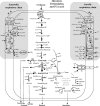The redox regulator Fnr is required for fermentative growth and enterotoxin synthesis in Bacillus cereus F4430/73
- PMID: 17259311
- PMCID: PMC1855811
- DOI: 10.1128/JB.01701-06
The redox regulator Fnr is required for fermentative growth and enterotoxin synthesis in Bacillus cereus F4430/73
Abstract
Glucose-grown cells of Bacillus cereus respond to anaerobiosis and low extracellular oxidoreduction potentials (ORP), notably by enhancing enterotoxin production. This response involves the ResDE two-component system. We searched the B. cereus genome for other redox response regulators potentially involved in this adaptive process, and we identified one gene encoding a protein predicted to have an amino acid sequence 58% identical (80% similar) to that of the Bacillus subtilis Fnr redox regulator. The fnr gene of the food-borne pathogen B. cereus F4430/73 has been cloned and partially characterized. We showed that fnr was up-regulated during anaerobic fermentation, especially when fermentation occurred at low ORP (under highly reducing conditions). The expression of fnr was down-regulated in the presence of O(2) and nitrate which, unlike fumarate, stimulated the respiratory pathways. The inactivation of B. cereus fnr abolished fermentative growth but only moderately affected aerobic and anaerobic nitrate respiratory growth. Analyses of glucose by-products and the transcription profiles of key catabolic genes confirmed the strong regulatory impact of Fnr on B. cereus fermentative pathways. More importantly, the fnr mutation strongly decreased the expression of PlcR-dependent hbl and nhe genes, leading to the absence of hemolysin BL (Hbl) and nonhemolytic enterotoxin (Nhe) secretion by the mutant. These data indicate that fnr is essential for both fermentation and toxinogenesis. The results also suggest that both Fnr and the ResDE two-component system belong to a redox regulatory pathway that functions at least partially independently of the pleiotropic virulence gene regulator PlcR to regulate enterotoxin gene expression.
Figures




References
-
- Agaisse, H., M. Gominet, O. A. Okstad, A. B. Kolsto, and D. Lereclus. 1999. PlcR is a pleiotropic regulator of extracellular virulence factor gene expression in Bacillus thuringiensis. Mol. Microbiol. 32:1043-1053. - PubMed
-
- Arantes, O., and D. Lereclus. 1991. Construction of cloning vectors for Bacillus thuringiensis. Gene 108:115-119. - PubMed
-
- Bates, D. M., C. V. Popescu, N. Khoroshilova, K. Vogt, H. Beinert, E. Munck, and P. J. Kiley. 2000. Substitution of leucine 28 with histidine in the Escherichia coli transcription factor FNR results in increased stability of the [4Fe-4S](2+) cluster to oxygen. J. Biol. Chem. 275:6234-6240. - PubMed
Publication types
MeSH terms
Substances
Associated data
- Actions
LinkOut - more resources
Full Text Sources
Other Literature Sources
Research Materials

